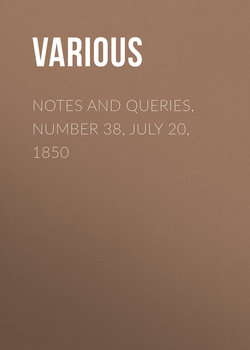Читать книгу Notes and Queries, Number 38, July 20, 1850 - Various - Страница 4
NOTES
DERIVATION OF EASTER
ОглавлениеSouthey, in his Book of the Church, derives our word Easter from a Saxon source:—
"The worship," he says, "of the goddess Eostre or Eastre, which may probably be traced to the Astarte of the Phoenicians, is retained among us in the word Easter; her annual festival having been superseded by that sacred day."
Should he not rather have given a British origin to the name of our Christian holy day? Southey acknowledges that the "heathenism which the Saxons introduced, bears no [very little?] affinity either to that of the Britons or the Romans;" yet it is certain that the Britons worshipped Baal and Ashtaroth, a relic of whose worship appears to be still retained in Cornwall to this day. The Druids, as Southey tells us, "made the people pass through the fire in honour of Baal." But the festival in honour of Baal appears to have been in the autumn: for
"They made the people," he informs us, "at the beginning of winter, extinguish all their fires on one day and kindle them again from the sacred fire of the Druids, which would make the house fortunate for the ensuing year; and, if any man came who had not paid his yearly dues, [Easter offerings, &c., date back as far as this!] they refused to give him a spark, neither durst any of his neighbours relieve him, nor might he himself procure fire by any other means, so that he and his family were deprived of it till he had discharged the uttermost of his debt."
The Druidical fires kindled in the spring of the year, on the other hand, would appear to be those in honour of Ashtaroth, or Astarte, from whom the British Christians may naturally enough have derived the name of Easter for their corresponding season. We might go even further than this, and say that the young ladies who are reported still to take the chief part in keeping up the Druidical festivities in Cornwall, very happily represent the ancient Estal (or Vestal) virgins.
"In times of Paganism," says O'Halloran, "we find in Ireland females devoted to celibacy. There was in Tara a royal foundation of this kind, wherein none were admitted but virgins of the noblest blood. It was called Cluain-Feart, or the place of retirement till death," &c … "The duty of these virgins was to keep up the fires of Bel, or the sun, and of Sambain, or the moon, which customs they borrowed from their Phoenician ancestors. They both [i.e. the Irish and the Phoenicians] adored Bel, or the sun, the moon, and the stars. The 'house of Rimmon' which the Phoenicians worshipped in, like our temples of Fleachta in Meath, was sacred to the moon. The word 'Rimmon' has by no means been understood by the different commentators; and yet, by recurring to the Irish (a branch of the Phoenician) it becomes very intelligible; for 'Re' is Irish for the moon, and 'Muadh' signifies an image, and the compound word 'Reamhan,' signifies prognosticating by the appearance of the moon. It appears by the life of our great S. Columba, that the Druid temples were here decorated with figures of the sun, the moon, and stars. The Phoenicians, under the name of Bel-Samen, adored the Supreme; and it is pretty remarkable, that to this very day, to wish a friend every happiness this life can afford, we say in Irish, 'The blessings of Samen and Bel be with you!' that is, of the seasons; Bel signifying the sun, and Samhain the moon."
—(See O'Halloran's Hist. of Ireland, vol. i. P. 47.)
J. SANSOM.
